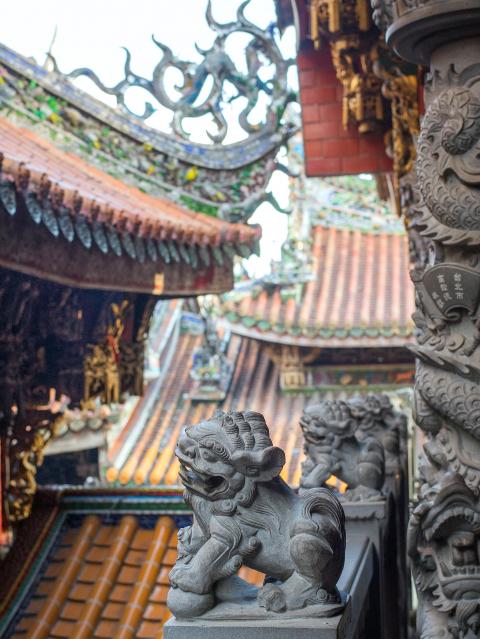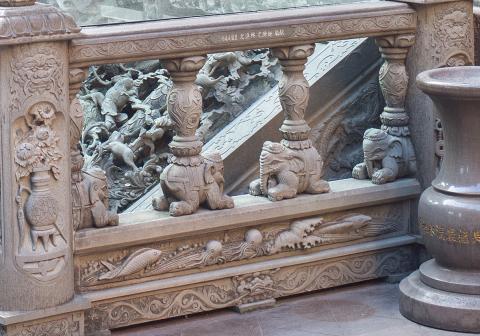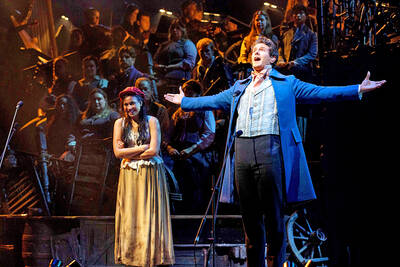New Taipei City’s Sanxia Zushih Temple, known as the “palace of oriental art,” is known for its traditional appeal and its unique carvings and decoration.
The initial plans to build the temple stretch back to the Qing dynasty. It was rebuilt twice during the 19th century and, after World War II, it came under the control of Sanxia Township. The then-representative of Sanxia Street, renowned artist Li Mei-shu, assumed responsibility for the supervision of the temple, commencing the temple’s third reconstruction in 1947.
Li took western elements and blended them seamlessly with the oriental temple architecture. In addition to the auspicious carvings of symbols such as gods, dragons, phoenixes and bats in the traditional Zushih Temple, you can also find many earthbound beasts, such as cats, dogs, pigs, goats, deer and bears; winged creatures like doves and owls; and even aquatic life, such as shrimp, crabs, octopi, squid, alligators and lobsters, all of which reward the careful observer. And among this exquisite craftsmanship are also concealed Cupid, angels from the Bible, and the mermaid of the children’s fable.

Photos: Paul Cooper, Taipei Times
照片:台北時報記者古德謙
If you look closely at the design of the temple, it soon becomes apparent that the third reconstruction of the temple was done using the “rival construction” method. That is, a tarpaulin was erected along the temple’s central axis to divide it into two sides — the dragon side and the tiger side — and two teams of artisans would, and according to Li’s instructions, work on their own carvings, expressing their own creativity, skills and ideas. As a result, the respective elements of the left and right sides of the temple are similar in size, and yet quite different in their forms, styles, and technique.
(Translated by Paul Cooper)
有「東方藝術殿堂」之稱的新北市三峽祖師廟,以古色古香、雕樑畫棟名聞遐邇。

Photos: Paul Cooper, Taipei Times
照片:台北時報記者古德謙
三峽祖師廟自清朝籌建,十九世紀歷經兩次重建,二次世界大戰後,祖師廟歸三峽鎮所有,由當時的代理三峽街長李梅樹接管,於民國卅六年進行第三次重建。
第三次重建的主持人李梅樹將西方元素不留痕跡地融入東方廟宇中。傳統的祖師廟裡,除了神明及龍、鳳、蝙蝠等象徵吉祥的雕刻,還能發現許多動物,舉凡地上走的貓、狗、豬、羊、鹿、熊,到天上飛的鴿子、貓頭鷹,甚至水裡的蝦子、螃蟹、章魚、魷魚、鱷魚、龍蝦等都有,細細觀察,趣味無窮。愛神丘比特、聖經中的天使、童話故事裡的美人魚也藏身在鬼斧神工的雕刻之中。
觀察祖師廟細部設計,不難發現第三次重建是採「對場作」的方式施工,亦即在廟宇中軸線,用布幔將龍邊、虎邊隔開,兩派工匠依照李梅樹的指揮,各自發揮創意、技巧與巧思來雕刻,因此建築左右兩邊相對應的元件,尺寸相似,但形狀、樣式、手法各異。(自由時報記者蔡百靈)

Rice is essential to Japanese culture, tradition and politics. People take pride in the oval-shaped sticky Japonica grain, which is still a staple even though total consumption has fallen over the decades. But since last summer, prices have soared as supplies have fallen short of demand. The government has long paid farmers to cut back on rice acreage, and change to other crops to keep rice prices relatively high. To cope with shortfalls this year, the government has released rice reserves. But the grain has been slow to reach supermarket shelves. Anger over that was part of the reason the Agriculture Minister

Step into any corner of Turkiye, and you’ll likely encounter the iconic “Evil Eye,” known as “nazar boncu?u” in Turkish. This striking blue glass ornament is shaped like an eye with concentric circles of dark blue, white, and light blue. While its name in English suggests something threatening, it’s actually a charm designed to ward off misfortune. The origins of the nazar boncu?u can be traced back to ancient Mediterranean and Middle Eastern traditions. The word nazar comes from Arabic, meaning “gaze,” while boncu?u translates to “bead” in Turkish. Central to the nazar boncu?u’s mythology is the idea that

A: Wow, Les Miserables Staged Concert Spectacular is visiting Taiwan for the first time. B: Isn’t Les Miserables often praised as one of the world’s four greatest musicals? A: Yup. Its concert is touring Taipei from tonight to July 6, and Kaohsiung between July 10 and 27. B: The English version of the French musical, based on writer Victor Hugo’s masterpiece, has been a huge success throughout the four decades since its debut in 1985. A: The musical has never toured Taiwan, but going to the concert sounds like fun, too. A: 哇,音樂劇《悲慘世界》紀念版音樂會首度來台巡演! B: 《悲慘世界》……它不是常被譽為全球四大名劇之一嗎? A: 對啊音樂會將從今晚到7月6日在台北演出,從7月10日到27日在高雄演出。 B: 這部法文音樂劇的英文版,改編自維克多雨果的同名小說,自1985年首演以來,在過去40年造成轟動。 A:

Continued from yesterday(延續自昨日) https://www.taipeitimes.com/News/lang In 1946, the company adopted the name 7-Eleven to reflect its newly extended __3__, from 7am to 11pm, a novel concept at the time. As a rapidly growing company, it began offering franchise opportunities in the 1960s. In 1974, the first 7-Eleven in Japan was opened by the supermarket company Ito-Yokado. The Japanese franchises were __4__ successful that by 1991, Ito-Yokado was able to acquire a 70 percent stake in Southland Corporation. Its investments eventually resulted in full ownership of 7-Eleven, which paved the way for the Japanese company to enter the international market. Since then, 7-Eleven